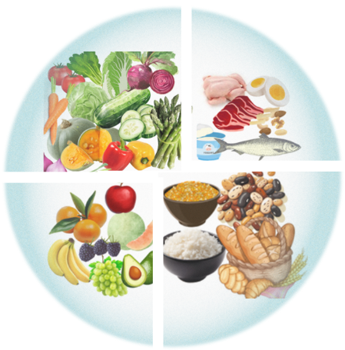What Is A Balanced Diet?
A Balanced Diet is a meal plan that provides all the essential nutrients—carbohydrates, proteins, fats, vitamins, minerals, fiber and water—in the right proportions.
It includes a variety of foods from all major food groups, ensuring enough energy for daily activities and supporting overall growth, immunity, and long-term health.
Following a balanced diet not only supports proper body functions but also helps prevent nutrient deficiencies and lifestyle-related diseases.

FDA-Recommended Nutrient Distribution in a Balanced Diet
The food guide pyramid helps in selecting the right combination of food groups for a healthy eating pattern.
-
Carbohydrates: 45–65% of total calories
-
Proteins: 10–35% of total calories
-
Fats: 20–35% of total calories
Along with these macronutrients, a diet should include micronutrients like vitamins, minerals, and dietary fiber for better digestion and immunity.
Eating for Wellness: Simple Rules for a Balanced Diet
Promoting an eating healthy campaign is essential for encouraging long-term wellness and preventing lifestyle diseases. Based on research data, the following healthy eating principles are advocated:
-
✅ Moderation in All Things
A balanced diet should include all essential food groups every day. Limit the intake of fats, oils, and sugars while focusing on whole foods. The food guide pyramid is a useful tool to plan meals. Include:
✅ Variety is the Spice of Life!
Ensure variety in diet by consuming different foods from each group. Avoid repetitive meals and food fads, as they can limit nutrition and affect social habits. A colorful plate ensures diverse nutrients for better health.
✅ Eat What is Enough!
Caloric requirements differ by age and gender. On average:
-
An adult man needs about 2,400 calories daily
-
An adult woman requires about 2,100 calories daily
-
Pregnant woman and Lactating mothers require additional calories of 300 and 450 respectively
Eating according to your body’s needs prevents both undernutrition and overeating.
✅ One Man’s Meat is Another Man’s Poison
Dietary patterns such as vegetarianism and non-vegetarianism influence health in different ways:
-
Vegetarian diets are often linked to a lower risk of obesity, heart disease, hypertension, and colon cancer due to higher intake of plant-based foods rich in fiber, antioxidants, and essential nutrients.
Vegan diets, which exclude all animal products, can provide many health benefits but may also increase the risk of nutrient deficiencies such as calcium, iron, and vitamin B12. Including whole grains, germinated seeds, fortified foods, and supplements can help maintain balance.
-
On the other hand, individuals who consume a high proportion of daily calories from non-vegetarian foods may face increased risks of cardiovascular disease, certain cancers, and type 2 diabetes, especially if the diet is rich in red or processed meats.
✅ Enough is as Good as a Feast
There is no single “perfect diet.” Instead, focus on choosing better food options every day. Humans are naturally omnivorous, and our body’s enzyme system adapts to different foods. The goal is to find balance and sustainability in your eating habits.
Balanced Diet Plan for Adults and Adolescents (2400 Calories)
The daily requirement for an adult sedentary male or an adolescent boy is approximately 2400 calories (1 unit of energy). Below is an ideal composition:
| Food Item | Quantity | Calories |
|---|---|---|
| Cereal | 400 g | 1400 |
| Legumes | 60 g | 230 |
| Roots & Tubers | 50 g | 50 |
| Vegetables | 50 g | 50 |
| Green Leafy Vegetables | 50 g | 50 |
| Fruits | 50 g | 50 |
| Milk / Curd | 250 ml | 150 |
| Oil / Fats | 30 g | 270 |
| Sugar | 30 g | 120 |
| Total | — | 2370 |
Non-Vegetarian Food Swap
To maintain balance, non-vegetarians can replace legumes with:
-
No legumes + 1 egg + 30 g meat/fish
-
No legumes, no egg + 60 g meat/fish
Key Takeaway
By following the right nutrient proportions, you can ensure a healthy lifestyle and prevent diet-related disorders. Medical Disclaimer.
Read further on:
≺≺ What Is the Ketogenic Diet? Is the Keto Diet Right for Everyone?
≺≺ Why should I combine Avocados and Tomatoes?
≺≺ Cholesterol: What Does Diet Have to Do with It?
≺≺ What foods should people with high blood pressure avoid?
≺≺ Why is regular table salt considered unhealthy?
≺≺ Kosher Salt: A Kitchen Essential Explained.
≺≺ What makes Himalayan salt different from regular table salt?
≺≺ Which food is most associated with helping people live longer?
≺≺ Is Plant-Based Protein the Key to a Longer, Stronger Life?
≺≺ How important is fiber in the diet?
≺≺ What cardiovascular benefits do berries provide?
≺≺ What is the Okinawan diet? What is the secret behind Okinawan long life-expectancy?
≺≺ Ultra-Processed Foods: What They Are, Why They’re Harmful, and How to Cut Back.
≺≺ What grains have the lowest glycemic index?
≺≺ How Important Is Protein for Your Health?
≺≺ is your kid getting too much protein?
≺≺ What foods and vitamins are good for your skin?
≺≺ EWG’s- The Clean Fifteen: Fruits and Vegetables with the Lowest Pesticide Levels.
≺≺ What eating strategies work best for losing weight long term?
≺≺ How Do Sugary Meals and Beverages Harm Dental Health?
≺≺ Why Vitamin B12 Is Important for Your Health?
≺≺ What food is most effective for moderating blood sugar?
≺≺ What are antioxidants? How antioxidants in the fruits and vegetables help in preventing cancers and diseases?
≺≺ How can I reduce the risk of cancer-causing chemicals when cooking or grilling meat?
≺≺ What happens to my blood vessels when I gain weight?
≻≻ Watch this page for more such informative articles on Health, Nutrition, and Wellness.
≻≻-Back to Home page.
Further reading (External Links opens in new window):
≺≺- Harvard Health Publishing – How the Dietary Guidelines define a healthy eating pattern.

